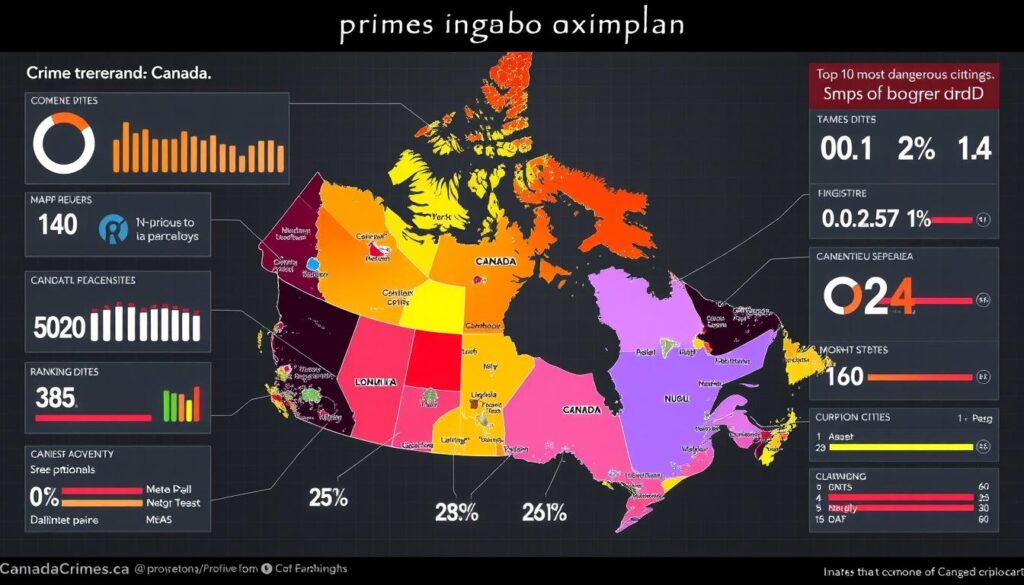Did you know that after years of decline, Canada’s Crime Severity Index (CSI) rose by 2% in 2023, marking the third consecutive year of increase?
This uptick in crime rates has sparked interest in understanding the current landscape of public safety across Canadian cities. According to Statistics Canada, the overall crime rate had been steadily declining since the late 1990s, as measured by the CSI and the Violent Crime Severity Index (VCSI).
The CSI takes into account both the volume and seriousness of criminal offenses, providing a comprehensive view of crime trends. As we explore the statistics and information behind Canada’s crime rates, it becomes clear that understanding these trends is crucial for assessing public safety.
Understanding Crime Measurement in Canada
To comprehend crime trends in Canada, it’s essential to understand the mechanisms used to measure crime. The country tracks criminal activity through a combination of statistics and specialized indices, providing a comprehensive view of the crime landscape.

The Crime Severity Index Explained
The Crime Severity Index (CSI) is a critical tool used to measure crime in Canada. It takes into account the severity of crimes, weighting each offense based on its seriousness. This allows for a more nuanced understanding of crime trends, as it doesn’t just count the number of crimes but also considers their impact. In 2023, the Violent Crime Severity Index (VCSI) and the Non-violent Crime Severity Index recorded values of 99.5 and 73.5, respectively, indicating a distinction in the severity of different types of crimes.
Violent vs. Non-Violent Crime Metrics
Canada tracks violent and non-violent crimes separately, allowing for targeted analysis of different types of criminal activity. The VCSI measures crimes against persons, including homicide, assault, and robbery, with each offense weighted according to its severity. In contrast, non-violent crimes, which include property crimes, are typically given lower severity weights. In 2023, there were 778 victims of homicide, a decrease of 104 cases from the previous year. Gang-related homicides accounted for about 22% of all homicides, with 78% of these committed using firearms, predominantly handguns.
Understanding these metrics is crucial for policymakers and law enforcement agencies to allocate resources effectively and address different types of criminal activity.
Current Crime Trends Across Canada
The crime landscape in Canada is evolving, influenced by a complex interplay of socioeconomic factors, law enforcement strategies, and demographic changes. Understanding these trends is crucial for developing effective crime prevention strategies.
Recent Changes in National Crime Rates
Recent data has shown significant changes in national crime rates, with certain categories experiencing notable increases. For instance, the overall Crime Severity Index (CSI) was significantly influenced by a rise in reported child pornography cases, which soared by 52% in 2023. This increase is attributed partly to enhanced awareness and better collaboration among law enforcement agencies. Other contributors to the CSI included increases in fraud and shoplifting rates, with fraud rising by 12% and shoplifting of amounts under $5,000 rising by 18%.
These changes highlight the evolving nature of crime in Canada, with both traditional and emerging crime types presenting challenges for law enforcement and policymakers.
Factors Influencing Crime Rate Fluctuations
Multiple complex factors influence crime rate fluctuations across Canadian cities. Economic indicators, such as unemployment rates and income inequality, have been shown to correlate with certain types of criminal activity, particularly property crimes. Demographic shifts also impact crime patterns, with areas experiencing rapid population growth or decline often seeing corresponding changes in their crime rates as community dynamics evolve.
Additionally, enhanced awareness and improved reporting mechanisms have contributed to increases in certain crime categories. Technological changes have created new criminal opportunities, with cybercrime and fraud showing substantial increases as criminals adapt to digital environments. Law enforcement priorities and resource allocation significantly impact which crimes are detected and reported, creating potential fluctuations in official statistics.

Canada City Crime Rates: Top 10 Most Dangerous Cities
The crime landscape in Canada is not uniform, with certain cities standing out for their high crime rates. While many Canadian cities are considered safe, there are areas that experience higher levels of criminal activity. Understanding which cities are most affected can provide insights into the underlying causes of crime and potential solutions.
North Battleford, Saskatchewan
North Battleford has been identified as one of the most dangerous cities in Canada, with a high Crime Severity Index. The city has struggled with violent crime, including incidents of assault and robbery. Efforts to address these issues have included community policing initiatives and partnerships with local organizations to provide support to at-risk populations.
Thompson, Manitoba
Thompson, Manitoba, is another city that has faced significant crime challenges. The city’s Crime Severity Index is notably high, driven in part by violent crimes. Local authorities have implemented strategies aimed at reducing crime, including increased police presence in high-risk areas and programs to engage youth in positive activities.
Prince Albert, Saskatchewan
Prince Albert has one of the highest Crime Severity Indexes in Canada. The city has experienced issues with both violent and non-violent crime. To combat these challenges, the city has launched various initiatives, including community-based programs to address the root causes of crime, such as poverty and substance abuse.
Duncan, British Columbia
Duncan, British Columbia, has seen a rise in its Crime Severity Index, driven by increases in both violent and non-violent crimes. The community has responded by implementing crime prevention programs, including neighborhood watch initiatives and collaborations with local law enforcement to enhance public safety.
Quesnel, British Columbia
Quesnel, British Columbia, had a Crime Severity Index of 322.3, marking a significant increase of 29.1% from the previous year. The Violent Crime Severity Index was 252.0, a 6.1% increase, while the Non-Violent Crime Severity Index rose by 37.6% to 353.0. With a population of approximately 12,110, Quesnel’s crime issues are notable. The city has faced economic challenges, particularly in the forestry industry, which may contribute to the rise in property crimes. Substance abuse has also been identified as a driver of criminal activity. Local authorities have responded with targeted strategies, including increased downtown patrols and community outreach programs.

As these cities demonstrate, crime is a complex issue influenced by a variety of factors, including economic conditions, substance abuse, and community resources. Addressing crime effectively requires a multifaceted approach that includes both law enforcement strategies and community-based initiatives.
Safest Cities in Canada by Crime Rate
Canada’s safest cities are characterized by their low crime rates and effective community policing strategies. These cities have managed to maintain public safety through a combination of strong community connections and proactive law enforcement initiatives.
LaSalle, Ontario
LaSalle, Ontario, is recognized for its low crime rate, contributing to its status as one of Canada’s safest cities. The community’s strong sense of cohesion and the local police service’s community-oriented policing strategies have played a significant role in maintaining public safety. With a focus on building trust between law enforcement and the community, LaSalle has seen a reduction in crime severity, making it an attractive place to live.
Halton Region, Ontario
The Halton Region in Ontario is another area that stands out for its safety. The region’s crime rate is lower than many other urban areas in Canada, thanks in part to its effective policing strategies and community engagement programs. The Halton Regional Police Service has implemented various initiatives aimed at preventing crime and enhancing public safety, contributing to the region’s reputation as a safe and secure place to reside.
South Simcoe, Ontario
South Simcoe, which includes Innisfil and surrounding areas, is notable for its remarkably low Crime Severity Index of 31.3, representing an 18.2% decrease from the previous year. The area’s Violent Crime Severity Index was 37.5, a significant drop of 35.5%, while the Non-Violent Crime Severity Index decreased by 5.2% to 29.1. With a population of approximately 29,464, South Simcoe’s declining crime rates across all major categories demonstrate the effectiveness of its policing strategies and community factors in achieving significant public safety improvements.

Provincial Crime Rate Comparisons
Canada’s crime rates vary significantly across provinces, with distinct patterns emerging between regions. Understanding these differences is crucial for developing effective crime prevention strategies and allocating resources appropriately.
Prairie Provinces: Manitoba and Saskatchewan
The Prairie Provinces, particularly Manitoba and Saskatchewan, have some of the highest crime rates in Canada. According to recent statistics from Statistics Canada, these provinces consistently report higher violent crime rates compared to other parts of the country. For instance, Saskatchewan’s Crime Severity Index is typically double that of many eastern provinces. The high crime rates in these areas are attributed to various factors, including higher proportions of the population living in rural and remote areas, where access to services is limited and police response times are longer. Additionally, the larger Indigenous populations in these provinces contribute to regional statistical differences, as Indigenous communities face higher victimization rates due to historical and systemic factors.
“The crime rates in Manitoba and Saskatchewan are a pressing concern, requiring targeted interventions and community-based programs to address the root causes of crime.”
Eastern vs. Western Canada Crime Patterns
A clear east-west divide exists in Canadian crime patterns, with eastern provinces generally reporting lower crime rates than their western counterparts. Atlantic provinces like Prince Edward Island, Nova Scotia, and New Brunswick consistently maintain Crime Severity Indexes below the national average. In contrast, western provinces, particularly Manitoba, Saskatchewan, and Alberta, report higher crime rates. British Columbia presents a mixed picture, with lower violent crime rates than the Prairie provinces but higher property crime rates, particularly in metropolitan Vancouver.
Economic factors also play a significant role in this divide, with resource-dependent western economies experiencing more boom-and-bust cycles that can contribute to social instability and associated crime patterns. As noted by crime experts,
“The economic instability in western Canada can lead to increased crime rates, making it essential to address these underlying issues.”

Types of Crime Affecting Canadian Cities
Canadian cities face a diverse array of crimes, including violent crime, property crime, and emerging threats like cybercrime. The complexity of these crimes demands a comprehensive understanding to develop effective prevention and intervention strategies.
Violent Crime Statistics
Violent crime remains a significant concern in many Canadian cities. Statistics indicate that violent crimes, including sexual assault and homicide, have seen fluctuations over the years. The impact of violent crime on communities is profound, affecting not only the victims but also their families and the broader community.
The rate of violent crime can be influenced by various factors, including socioeconomic conditions and the presence of community programs aimed at reducing violence.
Property Crime Trends
Property crime, encompassing theft, burglary, and vandalism, continues to be a prevalent issue in Canadian cities. Trends in property crime can be influenced by factors such as urban density and policing strategies. Recent data show that while some cities have seen a decrease in property crime, others have experienced an increase.
Effective policing and community engagement are crucial in addressing property crime and enhancing public safety.
Emerging Crime Concerns: Fraud and Cybercrime
Fraud and cybercrime are among the fastest-growing categories of crime in Canada. Between 2008 and 2018, fraud increased by 46%, and it continued to rise by 12% in 2023 alone. Cybercrime, including online harassment and extortion, has also seen a significant surge, with child pornography cases soaring by 52% in 2023.
| Type of Crime | Percentage Change | Year |
|---|---|---|
| Fraud | +46% | 2008-2018 |
| Fraud | +12% | 2023 |
| Cybercrime (Child Pornography) | +52% | 2023 |
| Extortion | +35% | 2023 (4th consecutive year) |
The rise in fraud and cybercrime poses significant challenges for law enforcement agencies, which must adapt to new technologies and criminal methodologies. Specialized police services, such as the RCMP’s National Cybercrime Coordination Centre, have been established to address these emerging threats.

The Canadian Criminal Code and Crime Classification
The Criminal Code of Canada plays a pivotal role in defining and classifying criminal offenses nationwide. It is a federal legislation that ensures uniformity in how crimes are categorized and prosecuted across different provinces and territories.
How Crimes Are Categorized
Crimes in Canada are categorized based on the Criminal Code, which outlines various offenses and their corresponding classifications. The Code differentiates between violent and non-violent crimes, with the former including offenses like assault and homicide, and the latter encompassing crimes such as theft and vandalism. According to Statistics Canada, the categorization of crimes helps in understanding the level of crime in different areas.
The Criminal Code is regularly updated to reflect emerging crime concerns, such as cybercrime and fraud, ensuring that law enforcement agencies and the justice system are equipped to handle new types of offenses. This categorization is crucial for police services and other law enforcement agencies to report and analyze crime statistics effectively.

Federal vs. Provincial Jurisdiction
The administration of justice in Canada involves a division of responsibilities between the federal government and the provinces. While the federal government is responsible for establishing the Criminal Code, provinces are tasked with law enforcement and the administration of justice within their boundaries. This includes managing youth criminal justice services and correctional facilities for sentences under two years.
Three provinces – Ontario, Quebec, and Newfoundland and Labrador – maintain their own provincial police services, while others contract with the Royal Canadian Mounted Police for provincial policing. This division creates regional variations in enforcement priorities and resource allocation, contributing to differences in crime statistics across provinces. A detailed report on these variations can provide insights into the effectiveness of different approaches to crime prevention and law enforcement.
Crime Prevention Strategies in Canadian Cities
Crime prevention in Canadian cities involves a multi-faceted approach, combining community efforts and law enforcement initiatives to bring about positive change in the city‘s safety landscape.
Community-Based Prevention Programs
Community-based prevention programs play a vital role in reducing crime rates across Canada. These programs focus on addressing the root causes of criminal behavior and fostering a sense of community. By engaging local residents and organizations, these initiatives promote social cohesion and provide support to at-risk individuals. For instance, community centers offering after-school programs for youth can help deter them from engaging in criminal activities, thereby effecting a change in their life trajectory.

Law Enforcement Initiatives
Law enforcement agencies in Canada are also taking proactive steps to prevent crime. The police are adopting evidence-based policing strategies, which involve analyzing data to identify high-crime areas and deploying resources effectively. For example, hot-spot policing has been successful in reducing violent homicide rates in cities like Toronto and Vancouver. Additionally, specialized units are being established to tackle specific types of crime, such as gang violence and cybercrime, ultimately leading to a change in the area‘s crime dynamics. According to a report, the ratio of police officers to population varies significantly across different regions in Canada.
Conclusion: Understanding the Canadian Crime Landscape
Canada’s crime landscape is characterized by regional variations and evolving crime patterns. Despite a 2% rise in the Crime Severity Index (CSI) in 2023, Canada remains one of the world’s safest countries, ranking 11th globally. The CSI measures the severity of crime, providing valuable insights for policymakers and law enforcement. Regional disparities exist, with eastern provinces generally experiencing lower crime rates than western provinces. As crime trends evolve, with technology-facilitated offenses like fraud and cybercrime on the rise, adaptive prevention strategies are crucial. Canada’s approach to crime prevention emphasizes addressing root causes through social development and community engagement.

